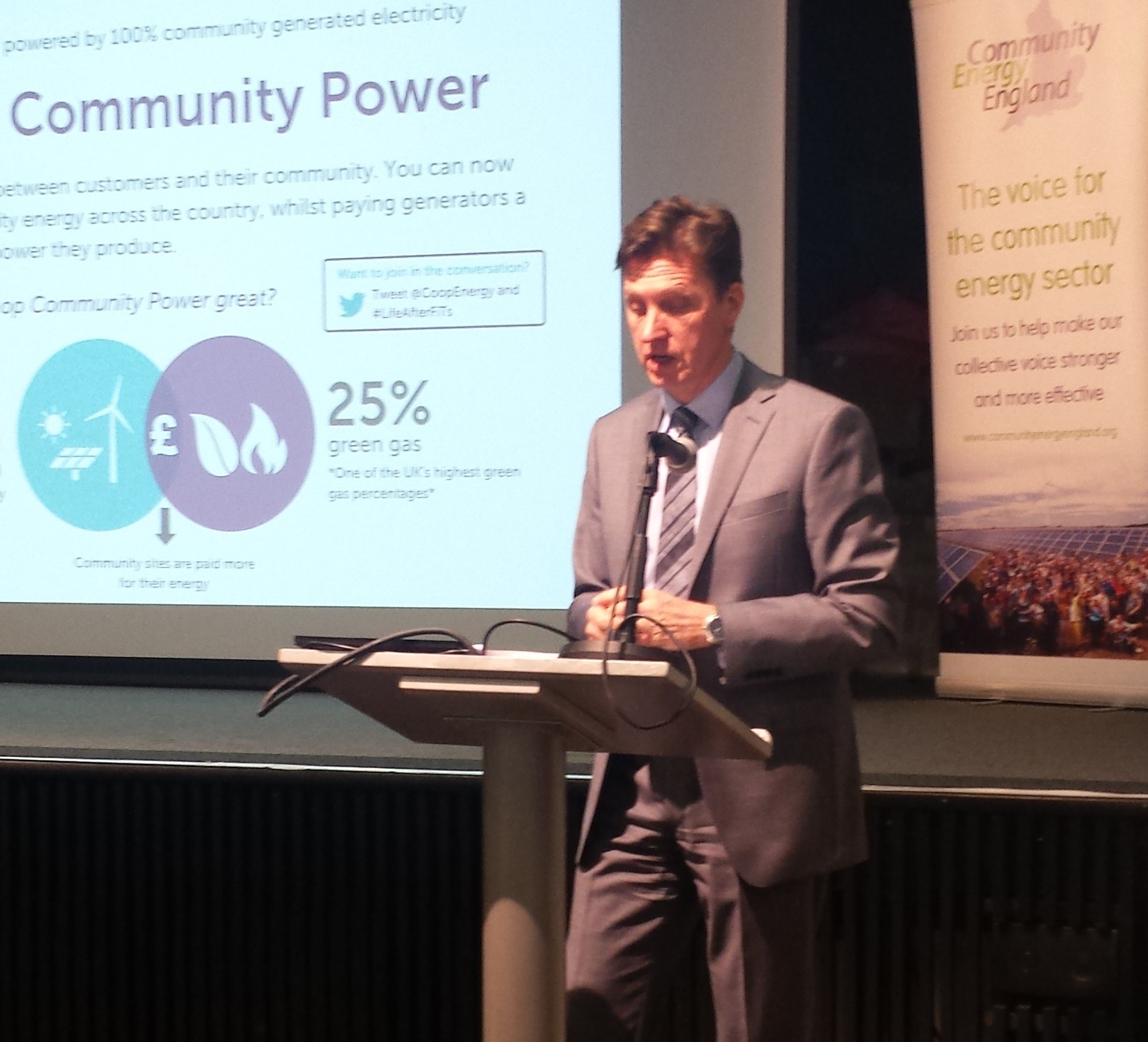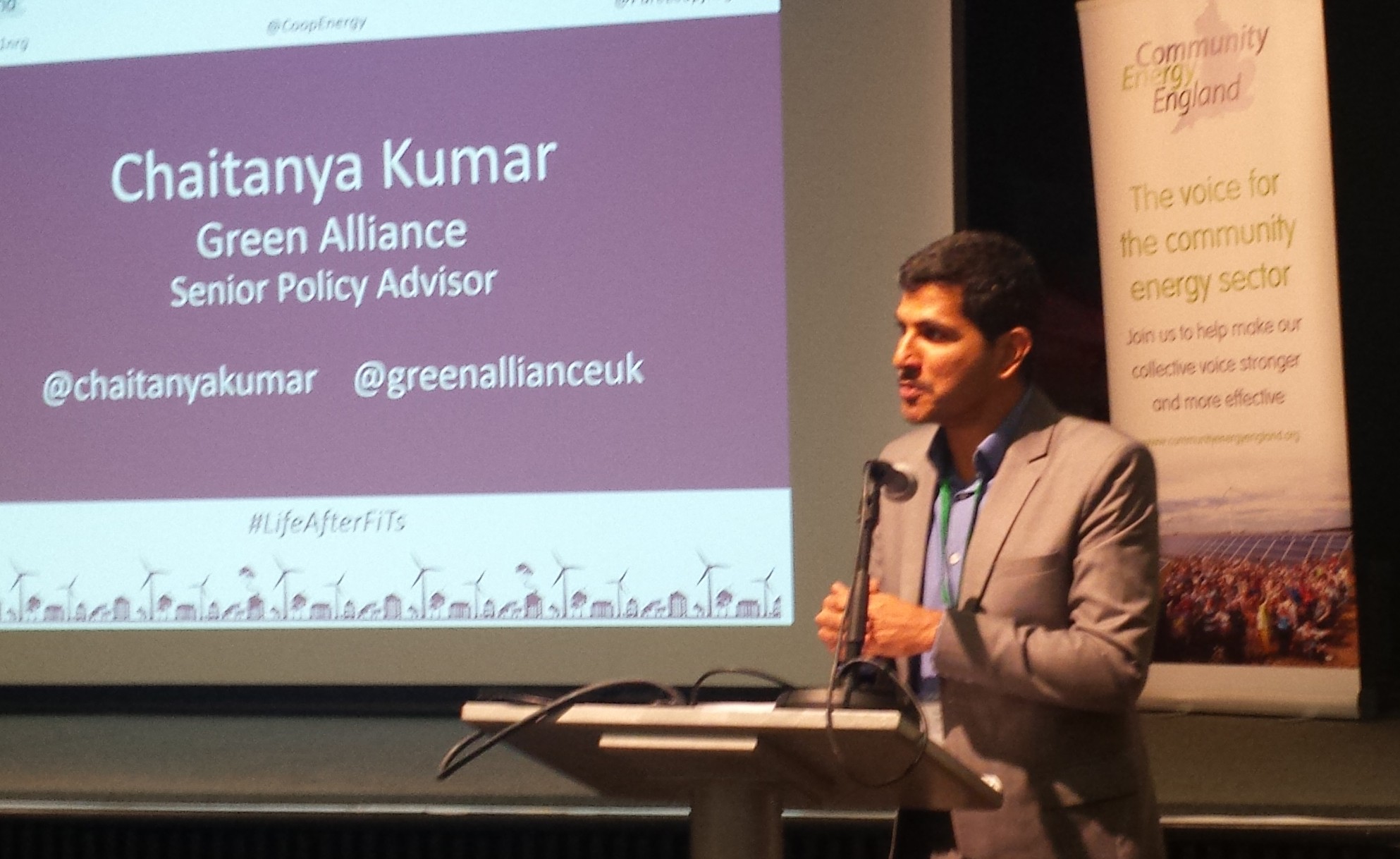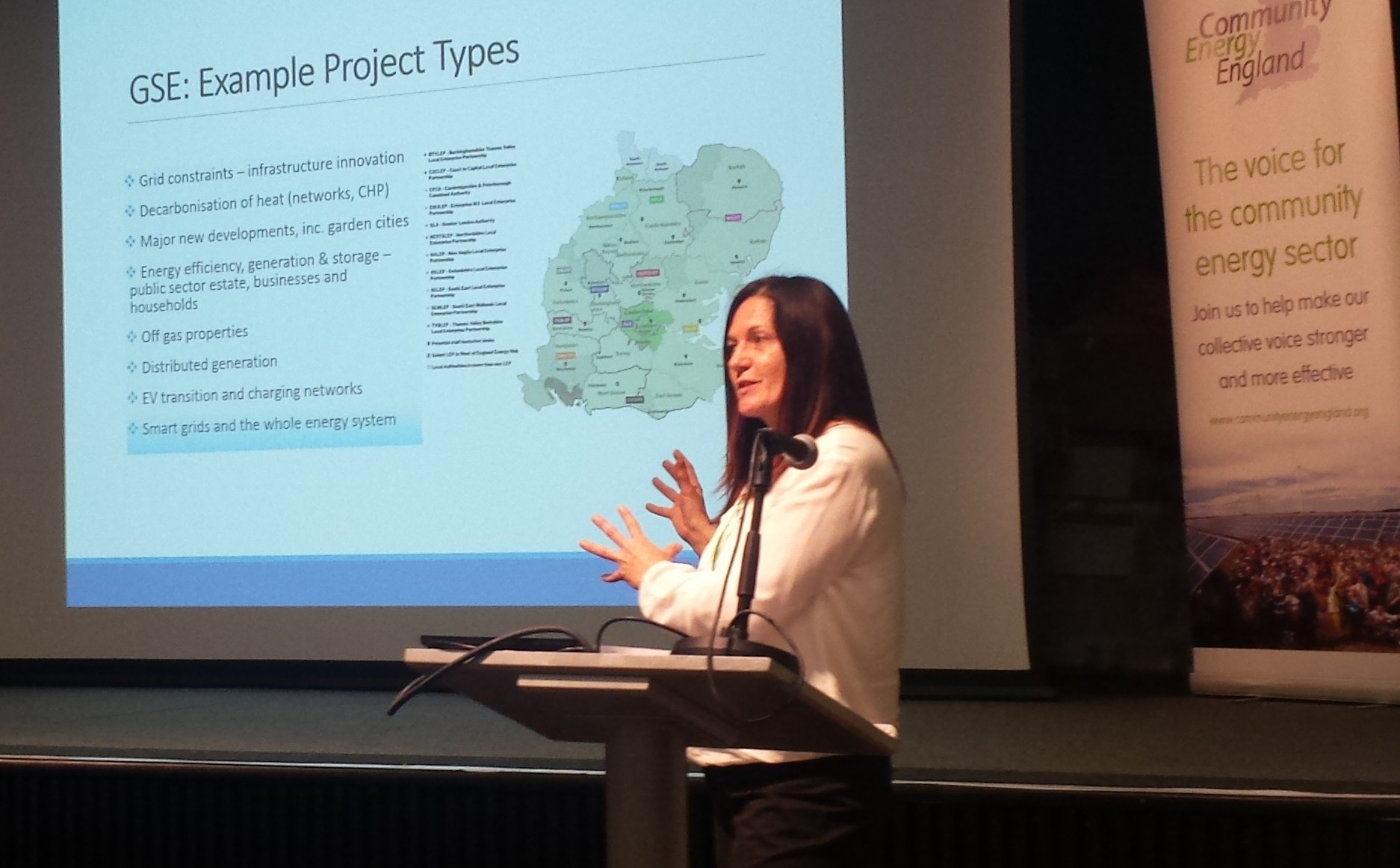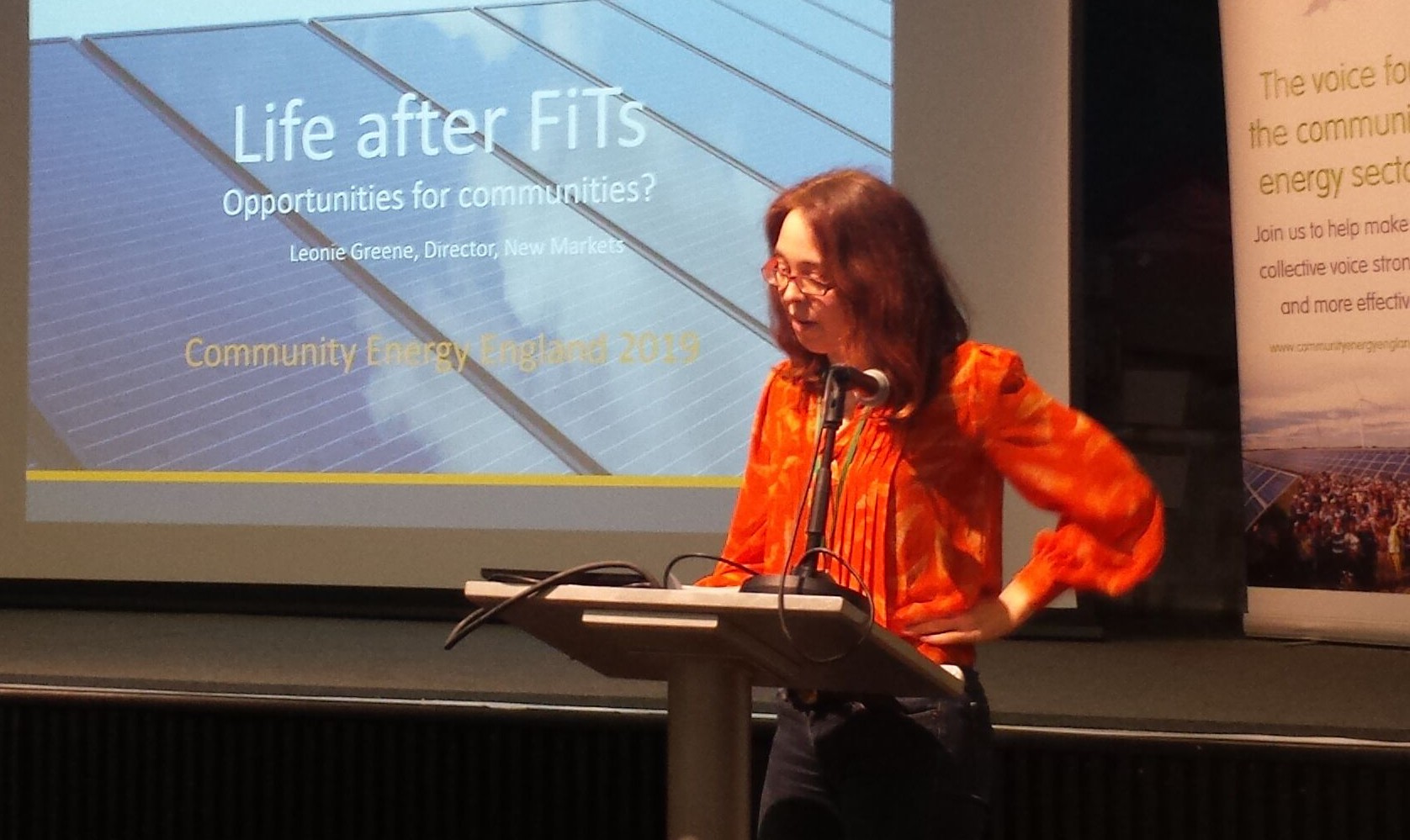As concerns over the environment mount, the pressure is mounting to build a greener energy system and transition the UK to a low-carbon economy – but at the same time, community energy projects in the UK are under pressure thanks to the withdrawal of feed-in tariffs (FITS).
The government has scrapped the system, which paid people for the renewable energy they produced, leaving the sector looking for new ways forward. In April, Community Energy England (CEE) held a meeting in London to explore new opportunities and business models.
Purchase deals and partnerships
After FITS, other avenues explored include purchase agreements between different organisations. David Bird, chief executive of Co-op Energy, Midcounties Co-op’s energy supplier, said his organisation was continuing to grow the number of community energy companies on its roster – the figure now stands at 79.

“But it’s a tough market,” he added, “and we saw 11 suppliers fall by the wayside this year.”
He highlighted that Co-op Energy is pushing the case for community energy generation to qualify for social investment tax relief, and said there was scope to drive further environmental improvement – for instance by replacing fossil fuels in domestic gas supplies with methane.
At the CEE meeting, Chaitanya Kumar, senior policy advisor at the Green Alliance, set out the policy landscape for small-scale generation, saying a decentralised energy system would bring economic opportunities for community energy.
He believes a more localised energy system raises “complex questions around data and emerging consumer choices”, with new actors emerging to capture value in the system from home battery storage and electric vehicles.

“We need to design markets for the emerging energy system with community energy in mind,” he said. “It’s often considered as a fringe entity rather than a must-have.”
He said there is still “a massive pot of money” for community energy businesses to chase, even after FITS – with energy-efficiency grants in funding for new-build homes, and increased social impact investment.
“There’s a lot of talk about the social value we bring,” he added, “but how do we get the market to appreciate the value? That isn’t happening.”
Mr Kumar said it was important to incentivise distribution network operators (DNOs) – companies which own and operate the UK’s pylon and electricity cable network – to engage with community energy businesses, and to create local energy efficiency models.
There is also scope for community energy to grow business and help green the sector by providing capacity to local authorities and local enterprise partnerships (LEPs). Local energy hubs, governed by the LEPs, have been set up to do this.
Maxine Narburgh, regional hub manager at Greater South East Energy Hub, told delegates that LEPs have produced energy plans as part of the government’s Clean Growth Strategy, and to suit local industrial strategies.
“Those strategies are where the money flows,” she said. This money can be accessed by promoting local energy schemes, partnerships and collaborations.
“Some local authorities are doing good things, ” she added, “but some aren’t even involved in this agenda.”

Ms Narburgh wants the LEPs to be “a conduit to the Department for Business, Energy and Industrial Strategy (BEIS) to influence policy”.
In June, the government’s department for Business, Energy & Industrial Strategy (BEIS) opens a two year programme of energy funding; in September it calls for applications, with all funds to be committed by March 2021.
To take advantage of such opportunities, “community energy businesses will need to work with Community Energy England and with local energy hubs … with collaboration in the energy transition for mutual benefit”.
Carbon reduction, clean growth, health and wellbeing are the “triple bottom line”, she added.

Léonie Greene, head of external affairs at the Solar Trade Association, said the withdrawal of FITs had been “very damaging – it’s caused a lot of casualties in the industry” but acknowledges there is growing interest in energy storage and smart technology.
However, the new regulatory environment means “we’re moving into a smaller market with affluent people,” she warned. “I worry about poorer people who might benefit from this being left behind.”
Social value investment
The question is how to get the market to reward social value. “Community energy delivers high value but it’s not recognised – and you can’t invest on basis of policy promises of jam tomorrow,” said Ms Greene.
As a solution, she said regulator Ofgem should adopt a culture more reflective of costs and benefits, and the climate framework agreed in Rio should be applied to local energy markets. “You need to lobby on that,” she told delegates. “Nobody has done an analysis of the cost benefits of decentralised energy. Until we get this officially recognised and quantified by Ofgem we’re not going to see the value of distributed energy reflected back.”
Dan Starman from sector consultant Pixie Energy, put forward another avenue the sector could pursue: lobbying for meter-splitting, ending the rule which means a meter can only have one supplier
The current rules mean community energy groups have to sign a contract with an energy supplier to get their power to the market. Meter splitting would allow bundled energy offers.
This is a “divisive” idea, Mr Starman admitted, which raises issues around consumer protection and billing – but it is also “forward thinking, equitable, locally focused, with fast data retrieval – which is where energy industry is behind. We don’t know how much energy a household has used till two years after the event.”
Andrew Morton, energy systems manager at Local Energy Scotland, shared findings of how various projects are performing as of April 2019.
“Small-scale wind and hydro are very difficult to make viable,” he said. “It’s difficult to get planning consent, but medium and large-scale wind looks to be most viable, with a good export rate. Solar is getting there, but it gets there with a high retail price.”
Cost reduction – through market intervention or match funding can make medium and large-scale projects viable, he added. And because community energy firms may soon lose the ability offset certain costs in tarriffs, they might need to make their costs viable instead – and operate just above the wholesale price.
From the Low Carbon Hub, chief executive Barbara Hammond and operation director Adriano Figueiredo presented a case study of Project Leo, a £40m renewable energy drive in Oxford, led by a partnership of government, private energy companies, local authorities, business start-ups and Oxford University researchers.
Mr Figueiredo said: “We’ve been looking at projects to do with efficiency, heat and storage but it often felt like we were hitting a brick wall. Our approach is to flick the system on its head, work out how we can balance the energy system from the bottom up and make the people the heart of the exchange.
“We have to meet people’s needs so people must be at the centre of changes we propose. We have to replace fossils with zero carbon energy and take into account the increasing demand from the electrification of transport and heat.
“Leo is much more reliant on local energy sources – it allows energy to be traded locally and peer to peer; it’s about freeing up capacity to let new demand in.”
Low Carbon Hub projects being used for Leo include predictive modelling to develop the capacity to use weather forecasts to predict the output from solar installations.
Referring to the latest Intergovernmental Panel on Climate Change report, Ms Hammond said: “Community renewables and the two degree limit are vital to human life.
“We’re not about living The Good Life and trying to be self sufficient,” she added, “That’s a dangerous things to do – we’re still going to need to move large quantities of energy from place to place and in time. But these changes bring serious governance issues and we need to involve people in a different way.
“It’s not just about affordability, it’s about accessibility. It’s about energy equity – we want to understand what energy equity means in the new market.”
Greening transport and utilities
Ollie Pendered, chief executive of Community Energy South (CES), was another speaker to stress the importance of social impact as a lever for scaling up the sector.
“We’re speaking up now, speaking up louder, we’ve got a voice that can be heard,” he said. “This year we reached over 6,1000 households; they saved £90,000 in total. And there are communities across the country where we can share our knowledge to develop projects.”
Ideas in London include a possible energy commons project in Leicester Square and new launches in the East End and docklands.
And his LEP is working with multi stakeholders across the south east, including Southern Water.
“Water companies are regulated,” he said. “Ofwat is pushing them toward work with social aspect, to care for the environment, and provide affordability for vulnerable companies.
“They want to be in communities – so why can’t our communities power that water infrastructure? Think large – Southern Water has more than 500 points of contact where they power their sites.”
CES is also running six pilot projects to power the railways through renewables, including Riding Sunbeams, a solar scheme being trialled with Network Rail in Aldershot, and Green Valley Lines in South Wales, where the devolved Assembly is trying to electrify transport.

In another partnership example, Claire Hanratty, chief executive of low carbon company Pure Leapfrog, said she had worked with Warrington Council on a large solar project.
“Those big scale projects not easy for community groups to get into,” she said. “But there are opportunities out there for the community sector and we need to make sure we give the councils and the LEPs what they are looking for.”
Mike Smyth, chair of green energy co-op Energy4All, added that FITs have not yet ended, with a full year of work to be done on projects that can be built. “By the time that has happened, regulations, technology and policy will have changed,” he said.
“England is woefully uncompliant with the regulations of Common Energy Market – if we’re still in it after Brexit, there will be work to bring it into line.”
And there are a number of projects that can work with out FITs, including community heat – using ground loops, incinerators, biomass burners, solar installations or anaerobic digestors – and microgrids for industrial estates or blocks of flats, which mean more solar can be put into a system.
There are also grants – for instance in London and Dorset – which are funded by carbon offsetting fees on new developments which haven’t put in enough renewables. “They have to pay into a fund and those funds are building up – we’ve got a grant of £5,000 for a school project. These sums are now available.”
There are now 17,000 heat networks in UK, supplying 500,000 customers, and this provides a “huge opportunity to get people off fossils”.
With a target of 43% of demand met by heat networks by 2050, the government has committed £320m funding for heat networks to 2021, with 2bn of capital investment.
This offers opportunities for the co-op sector to tap into green energy funding, said Mr Smyth. He pointed out that in Denmark; the co-op model dominates and the “commercial sector and public sector have been largely driven out”.